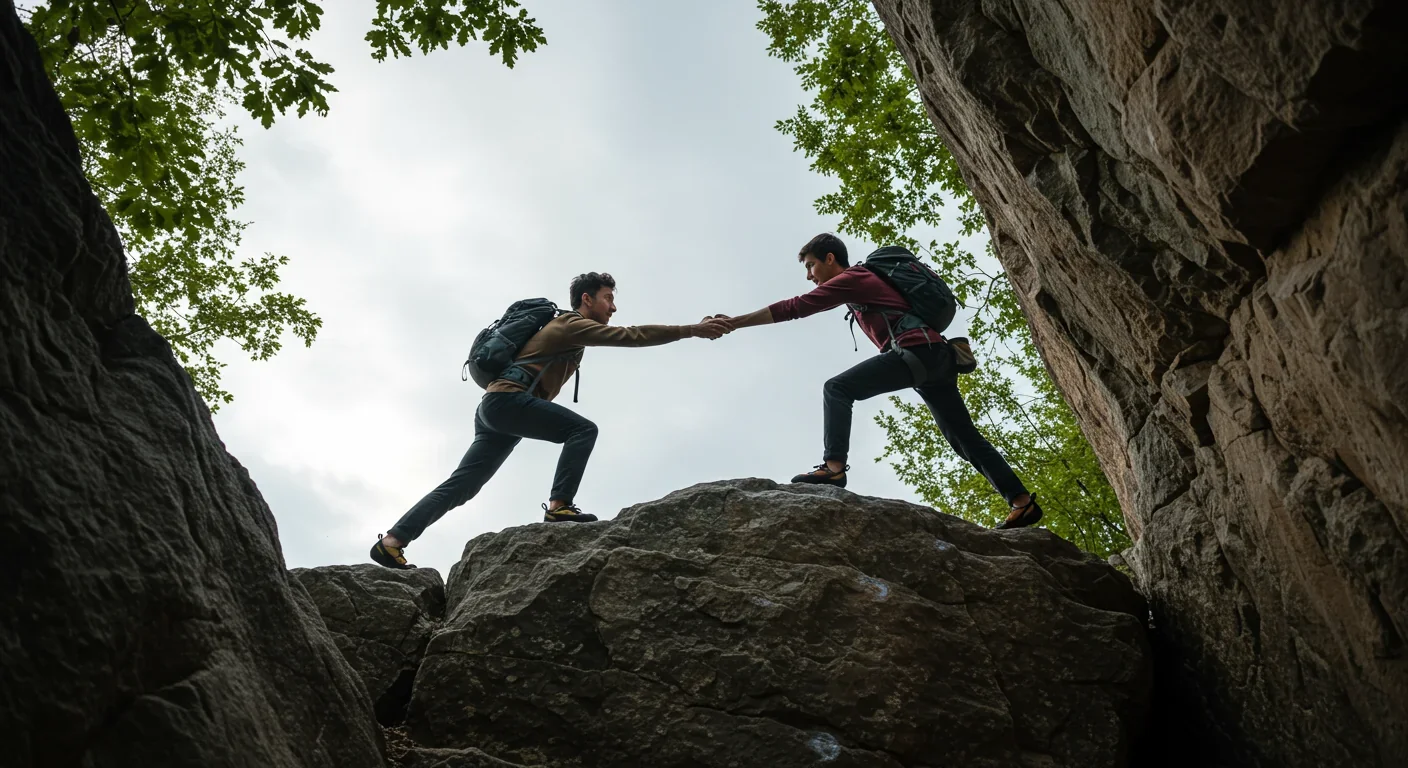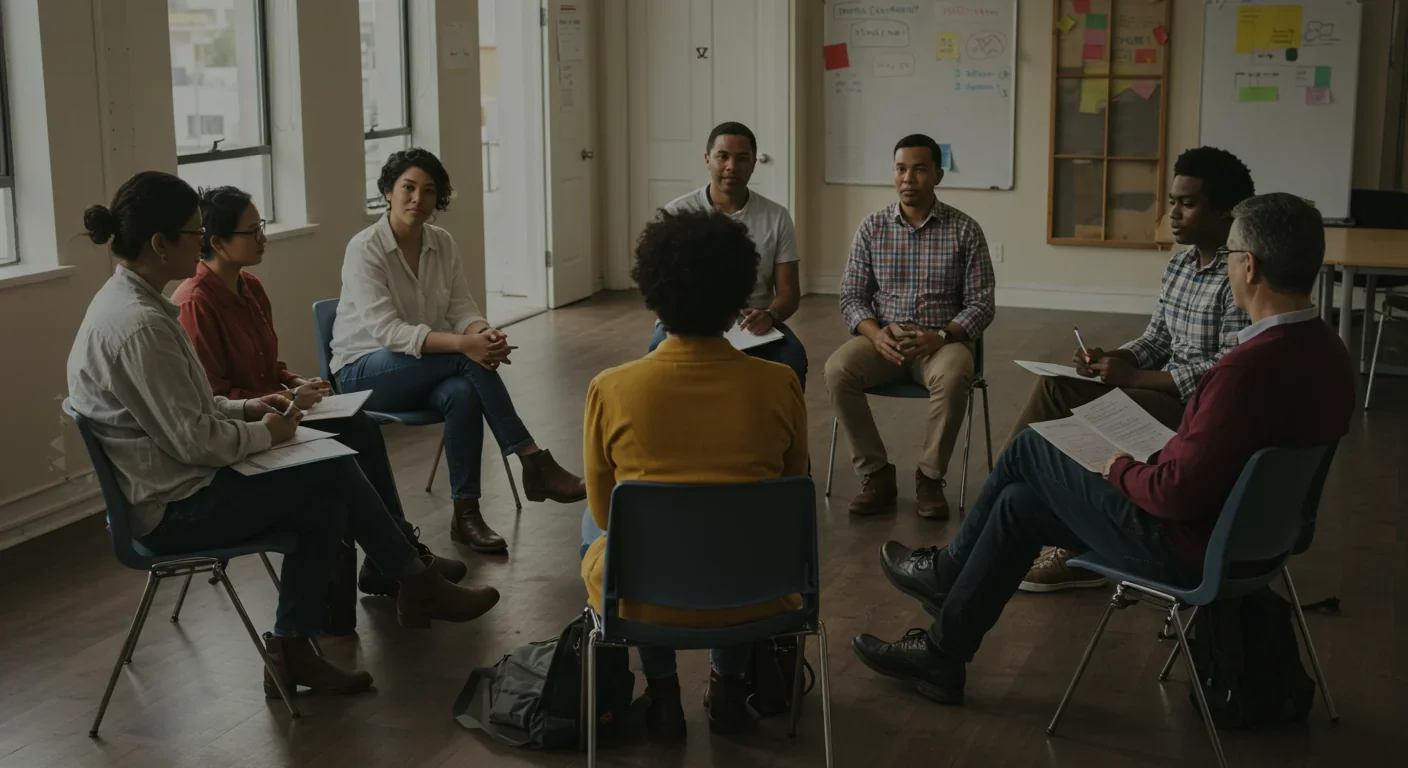Why Your Brain Sees Gods and Ghosts in Random Events

TL;DR: Human altruism evolved through kin selection, reciprocal cooperation, and cultural institutions that reward helping and punish cheating. Our brains are wired to feel good about cooperation, making selfishness and generosity surprisingly compatible evolutionary strategies.

Picture a vampire bat returning hungry to its roost after a failed hunting night. Without intervention, it will die within 60 hours. But instead of perishing, another bat—sometimes a relative, sometimes just a friend—regurgitates blood directly into its mouth, sharing up to 15% of its body weight. This isn't random charity. The bats keep mental ledgers of who helped whom, and cheaters get cut off.
If bats can build sophisticated networks of reciprocal altruism, what does that tell us about humans? Turns out, quite a lot. The question isn't whether evolution shaped our capacity for cooperation—it's how such counterintuitive behavior beat out selfishness in the brutal mathematics of natural selection.
At first glance, altruism shouldn't exist. Darwin himself worried about this. If evolution favors those who maximize their own reproductive success, why would anyone sacrifice resources, time, or safety for others? A gene that makes you give away your food should disappear faster than free samples at a grocery store.
Yet humans are spectacularly generous. We donate billions to strangers, risk our lives for friends, and feel genuine distress when others suffer. We even help people we'll never meet again. This prosocial behavior permeates every culture studied, though its expression varies wildly.
The resolution to Darwin's puzzle came in stages, each revealing a different engine driving cooperation.
In 1964, biologist W.D. Hamilton cracked the first part of the code with an elegant equation. He showed that a gene for altruism could spread if the benefit to the recipient (B), weighted by genetic relatedness (r), exceeded the cost to the donor (C). The formula—rB > C—became the foundation of kin selection theory.
In plain English: you should help relatives because they carry copies of your genes. Save two siblings or eight cousins, and genetically speaking, it's as good as saving yourself. This is why parents will die for their children, and why the phrase "blood is thicker than water" resonates across cultures.
But Hamilton's rule doesn't explain why we help strangers. For that, we need a different mechanism.
Robert Trivers introduced the second breakthrough in 1971: reciprocal altruism. The idea is deceptively simple. I'll scratch your back if you scratch mine later. But for this to work evolutionarily, several conditions must hold. You need repeated interactions, the ability to recognize individuals, memory to track who helped before, and mechanisms to punish cheaters.
This is where those vampire bats come back in. Researchers discovered that their blood-sharing follows these exact rules. Bats that refuse to share get frozen out of the network. The system is so precise that scientists can predict who will share with whom just by watching grooming patterns—the bats' version of relationship maintenance.
Humans do this too, though we call it reputation. Psychologist Robert Cialdini showed that reciprocity is so powerful it overrides personal preference. In one classic experiment, people were more likely to buy raffle tickets from someone who'd given them a free soda—even if they didn't particularly like that person.
The strength of reciprocity varies by context. It's weaker in professional B2B settings where favors feel strategic, but stronger in collectivistic cultures where social bonds carry more weight. Still, the basic pattern shows up everywhere humans gather.

To understand why reciprocity sticks around, mathematicians turned to game theory, particularly the famous Prisoner's Dilemma. Two suspects are interrogated separately. If both stay silent, they get light sentences. If both betray each other, they get moderate sentences. But if one betrays while the other stays silent, the betrayer walks free while the silent one gets maximum punishment.
The rational move in a single game is always to betray. But repeat the game many times, and everything changes. Political scientist Robert Axelrod ran tournaments where different strategies competed in iterated Prisoner's Dilemmas. The winner? A simple strategy called Tit for Tat: cooperate on the first move, then copy whatever your opponent did last time.
Tit for Tat works because it's nice (never betrays first), retaliatory (punishes defection), forgiving (resumes cooperation if the other player does), and transparent (easy to understand). Experimental studies confirm that this strategy thrives in evolutionary simulations, creating what biologists call an evolutionarily stable strategy—a pattern that, once established, resists invasion by alternatives.
The implications are profound. Cooperation doesn't require saints; it just needs repeated interactions and consequences for betrayal.
Evolution didn't just program our behavior; it wired our brains to feel cooperation. When you help someone, your brain releases oxytocin, dopamine, and endorphins—the same neurochemicals involved in bonding, pleasure, and pain relief. Acts of generosity activate the brain's reward centers, lighting up regions associated with food, sex, and other survival-critical activities.
This isn't accidental. Natural selection favored individuals whose brains made cooperation feel good because those individuals were more likely to build the alliances that increased survival. Recent research shows that oxytocin increases our sensitivity to harming others, making us more altruistic when we perceive potential loss—a neurochemical nudge toward preventing social harm.
Empathy serves as the psychological infrastructure for altruism. Our ability to mentally simulate others' experiences lets us predict their needs and adjust our behavior accordingly. This capacity appears early in development; even toddlers show distress at others' pain and attempt to comfort them.
Interestingly, empathy isn't uniform across contexts. We feel it more intensely for people who look like us, belong to our groups, or whom we've helped before. These biases reflect the evolutionary origins of empathy as a tool for navigating complex social hierarchies, not abstract moral reasoning.
Here's where the story gets really interesting. Around 10,000 years ago during the Great Holocene Transformation, human societies began scaling up dramatically. Hunter-gatherer bands of 50 people gave way to chiefdoms, then states, then civilizations of millions.
Genetic evolution couldn't keep pace with this explosion. Instead, cultural evolution took over. Societies developed institutions—religions, legal systems, moral codes—that promoted cooperation among strangers who shared no genetic ties and might never interact again.
A 2022 study in Science Advances found that agriculture and warfare, more than technological innovation, predicted increased societal complexity. Why? Because both created intense competition between groups. Societies with better cooperation mechanisms—stronger norms, more effective punishment of free-riders, shared ideologies—outcompeted those without them.
This cultural group selection explains seemingly irrational behaviors like dying in battle for your nation or donating to charity. These acts don't benefit individuals genetically, but they strengthen the cultural groups that survive and spread.

Cooperation has an enforcer, and it's not gentle. Across cultures, humans use punishment and ostracism to maintain group norms. A comprehensive meta-analysis found that punishment increased cooperation with an effect size of d=0.70—larger than reward's d=0.51.
Tight cultures with stricter norm enforcement show lower violent crime rates, suggesting that social policing works. But there's a cost. Societies with high punishment rates also tend toward conformity and reduced innovation.
The emotional fuel for punishment isn't anger alone. Recent research across 20 countries found that guilt, not shame, motivates generosity. Guilt focuses on specific actions you can repair; shame attacks your whole identity. Guilt says "I did something bad," while shame says "I am bad." Only the former drives prosocial repair attempts.
Incidental emotions matter too. Feeling guilty about one thing makes you more generous in unrelated contexts, as if your brain is trying to restore moral equilibrium. Marketing and fundraising campaigns exploit this constantly.
Today's cooperation challenges dwarf anything our ancestors faced. Climate change requires coordination among billions of people across nations with conflicting interests. Digital platforms create networks where reciprocity norms are still forming. Anonymous online interactions strip away the reputation mechanisms that traditionally enforced cooperation.
Yet the same evolutionary tools still apply. Public goods games in experimental economics show that people will contribute to shared resources when they can punish free-riders and when contributions are visible. Transparency and accountability aren't just bureaucratic ideals; they're prerequisites for large-scale cooperation.
The digital age has weaponized reciprocity in new ways. Algorithms engineer engagement by exploiting the norm: like my post and I'll like yours, follow for follow. This creates what some researchers call "hollow reciprocity"—interactions that mimic cooperation's form without its substance.
Understanding cooperation's evolutionary roots doesn't just satisfy curiosity; it offers practical leverage. In workplaces, fostering repeated interactions and making contributions visible increases team cooperation. Studies show that even small gestures of recognition activate reciprocity norms more effectively than large, impersonal bonuses.
In philanthropy, emphasizing shared identity and making impact transparent drives donations. People give more when they see concrete results and feel connected to beneficiaries—modern echoes of kin selection and reciprocity.
For social policy, the evidence suggests that systems balancing reward and punishment work better than either alone. The meta-analysis found that costly incentives outperform free ones, implying that skin in the game matters for both individuals and institutions.
Here's the twist that still surprises people: altruism evolved through fundamentally selfish processes. Genes that made organisms cooperate spread not because cooperation is morally good, but because it worked. The selfish gene, as Richard Dawkins famously put it, can build remarkably unselfish bodies.
This doesn't diminish the beauty or value of human kindness. It explains why kindness exists and under what conditions it flourishes. We're not cooperation machines; we're context-sensitive cooperators. We help kin more than strangers, reciprocate generosity, punish cheaters, and form alliances that serve our interests.
The good news is that our interests align with cooperation far more often than cynics assume. Most social situations are iterated games where reputation matters. Most groups benefit from shared resources. Most people carry both the biological hardware and cultural software to build trust.
The coming decades will test humanity's cooperative abilities like never before. Pandemics, climate disruption, AI governance—these challenges require coordination across scales our ancestors never imagined. Recent work on vaccination models applies evolutionary game theory to public health, showing how cooperation frameworks can address modern collective action problems.
The vampire bats have been sharing blood for millions of years using reciprocity principles we're only now fully grasping. They offer an unexpected lesson: cooperation doesn't require moral philosophy or religious commandments. It requires memory, repeated interaction, and consequences.
We have those tools, enhanced by technology that lets us track reputations globally and communicate instantly. Whether we use them to build cooperation or enable new forms of exploitation depends on understanding the deep evolutionary logic that made us social creatures in the first place.
Evolution made us altruists not despite selfishness, but through it. The genes that built brains capable of empathy, institutions that enforce fairness, and cultures that celebrate generosity didn't do so out of kindness. They did it because in the long run, on average, across millions of iterations, cooperation beat defection.
That's not a bug in human nature. It's the feature that built civilization.

Recent breakthroughs in fusion technology—including 351,000-gauss magnetic fields, AI-driven plasma diagnostics, and net energy gain at the National Ignition Facility—are transforming fusion propulsion from science fiction to engineering frontier. Scientists now have a realistic pathway to accelerate spacecraft to 10% of light speed, enabling a 43-year journey to Alpha Centauri. While challenges remain in miniaturization, neutron management, and sustained operation, the physics barriers have ...

Epigenetic clocks measure DNA methylation patterns to calculate biological age, which predicts disease risk up to 30 years before symptoms appear. Landmark studies show that accelerated epigenetic aging forecasts cardiovascular disease, diabetes, and neurodegeneration with remarkable accuracy. Lifestyle interventions—Mediterranean diet, structured exercise, quality sleep, stress management—can measurably reverse biological aging, reducing epigenetic age by 1-2 years within months. Commercial ...

Data centers consumed 415 terawatt-hours of electricity in 2024 and will nearly double that by 2030, driven by AI's insatiable energy appetite. Despite tech giants' renewable pledges, actual emissions are up to 662% higher than reported due to accounting loopholes. A digital pollution tax—similar to Europe's carbon border tariff—could finally force the industry to invest in efficiency technologies like liquid cooling, waste heat recovery, and time-matched renewable power, transforming volunta...

Humans are hardwired to see invisible agents—gods, ghosts, conspiracies—thanks to the Hyperactive Agency Detection Device (HADD), an evolutionary survival mechanism that favored false alarms over fatal misses. This cognitive bias, rooted in brain regions like the temporoparietal junction and medial prefrontal cortex, generates religious beliefs, animistic worldviews, and conspiracy theories across all cultures. Understanding HADD doesn't eliminate belief, but it helps us recognize when our pa...

The bombardier beetle has perfected a chemical defense system that human engineers are still trying to replicate: a two-chamber micro-combustion engine that mixes hydroquinone and hydrogen peroxide to create explosive 100°C sprays at up to 500 pulses per second, aimed with 270-degree precision. This tiny insect's biochemical marvel is inspiring revolutionary technologies in aerospace propulsion, pharmaceutical delivery, and fire suppression. By 2030, beetle-inspired systems could position sat...

The U.S. faces a catastrophic care worker shortage driven by poverty-level wages, overwhelming burnout, and systemic undervaluation. With 99% of nursing homes hiring and 9.7 million openings projected by 2034, the crisis threatens patient safety, family stability, and economic productivity. Evidence-based solutions—wage reforms, streamlined training, technology integration, and policy enforcement—exist and work, but require sustained political will and cultural recognition that caregiving is ...

Every major AI model was trained on copyrighted text scraped without permission, triggering billion-dollar lawsuits and forcing a reckoning between innovation and creator rights. The future depends on finding balance between transformative AI development and fair compensation for the people whose work fuels it.